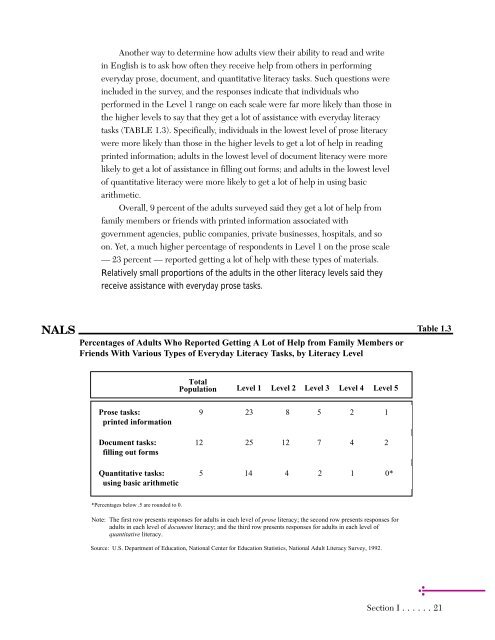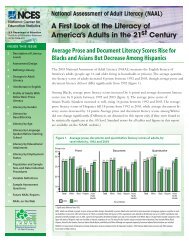Adult Literacy in America - National Center for Education Statistics ...
Adult Literacy in America - National Center for Education Statistics ...
Adult Literacy in America - National Center for Education Statistics ...
Create successful ePaper yourself
Turn your PDF publications into a flip-book with our unique Google optimized e-Paper software.
NALS<br />
Another way to determ<strong>in</strong>e how adults view their ability to read and write<br />
<strong>in</strong> English is to ask how often they receive help from others <strong>in</strong> per<strong>for</strong>m<strong>in</strong>g<br />
everyday prose, document, and quantitative literacy tasks. Such questions were<br />
<strong>in</strong>cluded <strong>in</strong> the survey, and the responses <strong>in</strong>dicate that <strong>in</strong>dividuals who<br />
per<strong>for</strong>med <strong>in</strong> the Level 1 range on each scale were far more likely than those <strong>in</strong><br />
the higher levels to say that they get a lot of assistance with everyday literacy<br />
tasks (TABLE 1.3). Specifically, <strong>in</strong>dividuals <strong>in</strong> the lowest level of prose literacy<br />
were more likely than those <strong>in</strong> the higher levels to get a lot of help <strong>in</strong> read<strong>in</strong>g<br />
pr<strong>in</strong>ted <strong>in</strong><strong>for</strong>mation; adults <strong>in</strong> the lowest level of document literacy were more<br />
likely to get a lot of assistance <strong>in</strong> fill<strong>in</strong>g out <strong>for</strong>ms; and adults <strong>in</strong> the lowest level<br />
of quantitative literacy were more likely to get a lot of help <strong>in</strong> us<strong>in</strong>g basic<br />
arithmetic.<br />
Overall, 9 percent of the adults surveyed said they get a lot of help from<br />
family members or friends with pr<strong>in</strong>ted <strong>in</strong><strong>for</strong>mation associated with<br />
government agencies, public companies, private bus<strong>in</strong>esses, hospitals, and so<br />
on. Yet, a much higher percentage of respondents <strong>in</strong> Level 1 on the prose scale<br />
— 23 percent — reported gett<strong>in</strong>g a lot of help with these types of materials.<br />
Relatively small proportions of the adults <strong>in</strong> the other literacy levels said they<br />
receive assistance with everyday prose tasks.<br />
Percentages of <strong>Adult</strong>s Who Reported Gett<strong>in</strong>g A Lot of Help from Family Members or<br />
Friends With Various Types of Everyday <strong>Literacy</strong> Tasks, by <strong>Literacy</strong> Level<br />
Prose tasks: 9 23 8 5 2 1<br />
pr<strong>in</strong>ted <strong>in</strong><strong>for</strong>mation<br />
Document tasks: 12 25 12 7 4 2<br />
fill<strong>in</strong>g out <strong>for</strong>ms<br />
Quantitative tasks: 5 14 4 2 1 0*<br />
us<strong>in</strong>g basic arithmetic<br />
*Percentages below .5 are rounded to 0.<br />
Total<br />
Population Level 1 Level 2 Level 3 Level 4 Level 5<br />
Note: The first row presents responses <strong>for</strong> adults <strong>in</strong> each level of prose literacy; the second row presents responses <strong>for</strong><br />
adults <strong>in</strong> each level of document literacy; and the third row presents responses <strong>for</strong> adults <strong>in</strong> each level of<br />
quantitative literacy.<br />
Source: U.S. Department of <strong>Education</strong>, <strong>National</strong> <strong>Center</strong> <strong>for</strong> <strong>Education</strong> <strong>Statistics</strong>, <strong>National</strong> <strong>Adult</strong> <strong>Literacy</strong> Survey, 1992.<br />
Table 1.3<br />
Section I ......21



